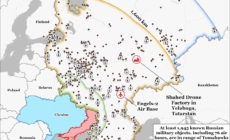-
Jorge Polanco crushes his second HR of game, extending Mariners’ lead over Tigers - 18 mins ago
-
Bari Weiss named editor-in-chief of CBS News as Paramount acquires The Free Press - 25 mins ago
-
Vojvodina Rider Claims Victory at 18th National Gallop - 27 mins ago
-
Cat Sees Dog Walking Past Store Daily, Response Goes Viral: ‘True Nemesis’ - 36 mins ago
-
Hungary Hails Georgian Municipal Election Results Amid Protests - 60 mins ago
-
NFL Top-10 Rankings: Lions Grab Top Spot; Eagles, Bills Drop; Bucs, Colts Climb - about 1 hour ago
-
Katie Porter gains endorsement of powerful group for Calif. governor - about 1 hour ago
-
Map shows where Russian targets could be destroyed with Tomahawk missiles - about 1 hour ago
-
King Charles’ former butler reveals surprising royal protocol rules - about 1 hour ago
-
Meta’s leaked AI documents expose internal child safety training rules - about 1 hour ago
Donald Trump Issues Major Housing Update
President Donald Trump has urged U.S. homebuilders to ramp up construction across the country, claiming they are “sitting on 2 million empty lots” while the nation continues navigating a housing shortage.
The lack of inventory on the U.S. market, which is due to the fact that the country built far fewer homes than needed following the subprime mortgage crisis of 2007-2010, has led to the surge in home prices during the recent pandemic home-buying frenzy.
In 2024, the U.S. housing supply gap was estimated to reach 3.8 million, according to Realtor.com, with the South being most affected (1.15 million) despite a homebuilding surge in the past five years. Experts at the company have estimated that it would take 7.5 years to fix the supply gap at the current rate of construction.
In the lead-up to the November 2024 election, Trump campaigned on a promise to boost housing inventory nationwide and lower borrowing costs, which have also shot through the roof since the Federal Reserve’s aggressive rate-hiking campaign of 2022.
But nine months into his new presidency, home prices are still rising, requests for construction permits are plummeting, and the national market has slowed to a crawl as skittish buyers stayed to the sidelines this summer.
As of August, the median sale price of a home was $439,278, up 1.5 percent from a year earlier. Inventory was over 2.1 million, up 10.6 percent, but sales were down by 2.3 percent as sellers outnumbered buyers by over 500,000, according to Redfin. The number of new homes listed on the market, however, was down by 6.7 percent as builders have realized it is not a good time to sell.
Why Is Donald Trump Pointing the Finger at Homebuilders?
In a post on his social media platform Truth Social on Sunday, the president blamed homebuilders for preventing him from fixing the country’s affordability crisis, comparing them to the Organization of the Petroleum Exporting Countries—better known as OPEC—for its role in keeping oil and gas prices high.
“Before I became President, ‘OPEC’ kept oil prices high. It wasn’t right for them to do that but, in a different form, is being done again—This time by the Big Homebuilders of our Nation,” he wrote.
“They’re my friends, and they’re very important to the SUCCESS of our Country, but now, they can get Financing, and they have to start building Homes. They’re sitting on 2 Million empty lots, A RECORD,” he added. “I’m asking Fannie Mae and Freddie Mac to get Big Homebuilders going and, by so doing, help restore the American Dream!”
It is unclear how the two mortgage financing giants would do what Trump wants. Fannie Mae and Freddie Mac—which the president has talked about taking off the government’s conservatorship they have been under since the 2008 financial crisis—together guarantee over half the country’s mortgages.
If Trump had his way, the two companies could facilitate loan processing to speed up new construction—but it remains to be seen whether builders would actually be interested.
What Are Homebuilders Doing?
Buyers have been discouraged by the current dynamics on the market, which have forced them to slash prices and offer other types of incentives to buyers to offload their homes.
According to the latest data by the National Association of Home Builders (NAHB), 39 percent of builders reported cutting prices in September, up from 37 percent in August and the highest percentage since the end of the pandemic. In the same month, the average price reduction was 5 percent in September, and the use of sales incentives was 65 percent, essentially unchanged from 66 percent in August.
Growing uncertainty around the U.S. economy and the impact of tariffs on their business is also chipping away at builders’ confidence in the future of the market.
In September, U.S. homebuilder sentiment stayed flat month-over-month at 32, the lowest level since December 2022, according to the NAHB.
Under the current circumstances, builders appear to be pulling back from the market. In August, housing starts—the number of new residential construction projects on which work has begun—plunged 8.5 percent from a month earlier to a seasonally adjusted annual rate of 1.307 million, according to Census data.
“Housing affordability is hurting buyer traffic for builders, and as a result builders have slowed single-family home construction,” said NAHB chairman Buddy Hughes in a recent statement.
Lower Mortgage Rates Might Boost Supply Even Without Trump’s Intervention
Slightly lower mortgage rates, which have fallen in anticipation of the Federal Reserve’s decision this month to cut its key rate for the first time since December 2024, are boosting builders’ confidence, experts say. As of the week ending October 2, the average 30-year fixed-rate mortgage was 6.34 percent, according to Freddie Mac.
“Our latest survey shows builders reported an increase for future market expectations as mortgage rates have posted a modest decline in recent weeks,” Hughes said.
“This return to monetary policy easing will help the mortgage market indirectly and lead to lower interest rates for building and land development loans, which will help builders to boost housing production,” said NAHB Chief Economist Robert Dietz.
But there is still a lot of uncertainty around what the coming months could bring to the country—exacerbated now by the federal shutdown. Experts generally agree that the Fed will cut rates twice more this year, but slowing job growth could put a spin on the work. This month, the shutdown has stopped the release of the new job report.
“There’s no good time for a shutdown, but this one is particularly ill-timed. The lack of updated labor data coincides with other signs of fragility in the economy,” Bankrate Senior Economic Analyst Mark Hamrick said in a statement shared with Newsweek.
“Federal Reserve Chair Jerome Powell has cautioned about ‘meaningful downside risk’ to the job market. Losing access to the most important gauge of job creation and unemployment magnifies the uncertainty around those risks,” he said.
“With the next Fed announcement set for October 29, officials must certainly be wondering how much data they’ll have available when deciding whether to cut interest rates again.”
Source link






























